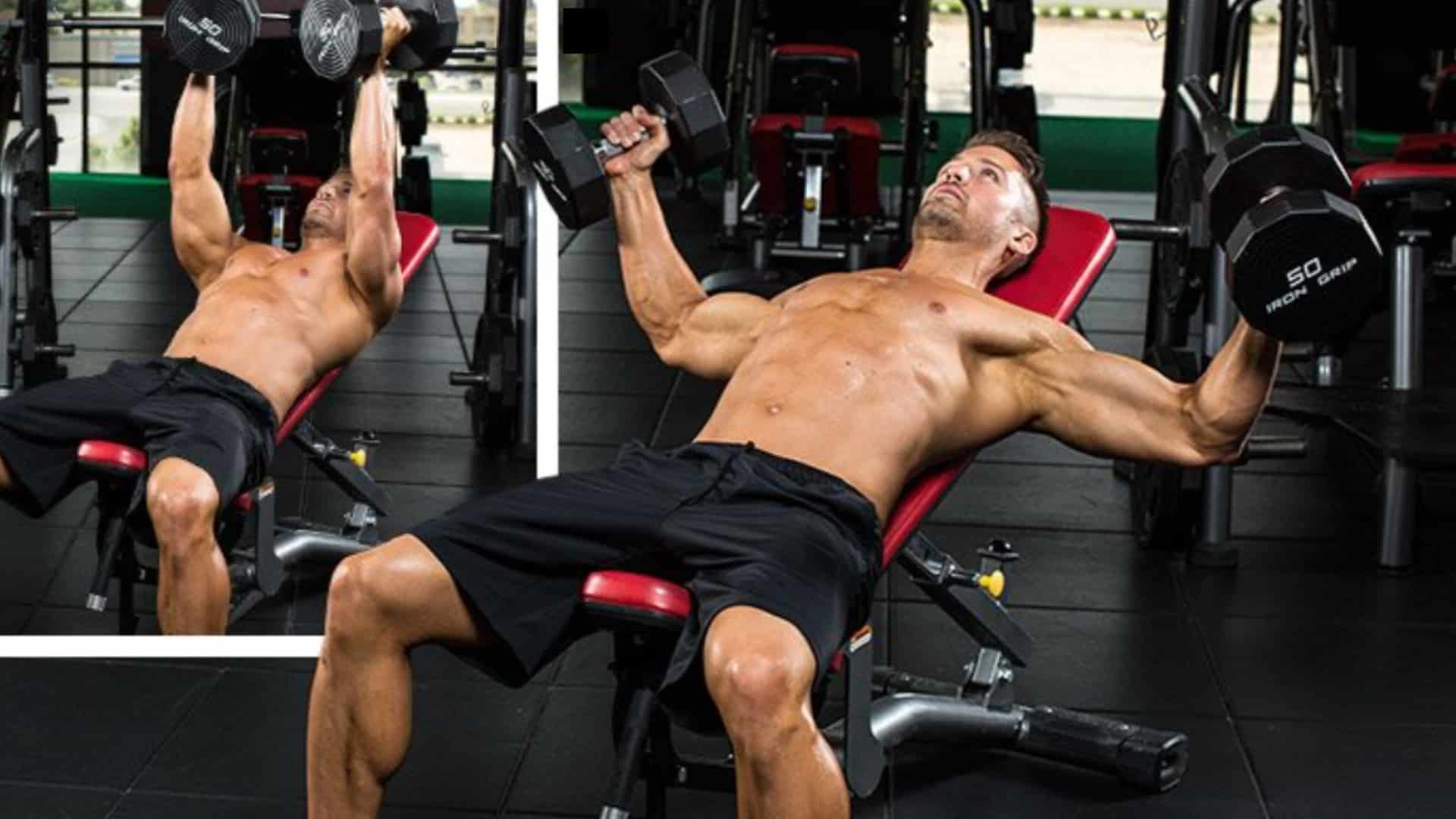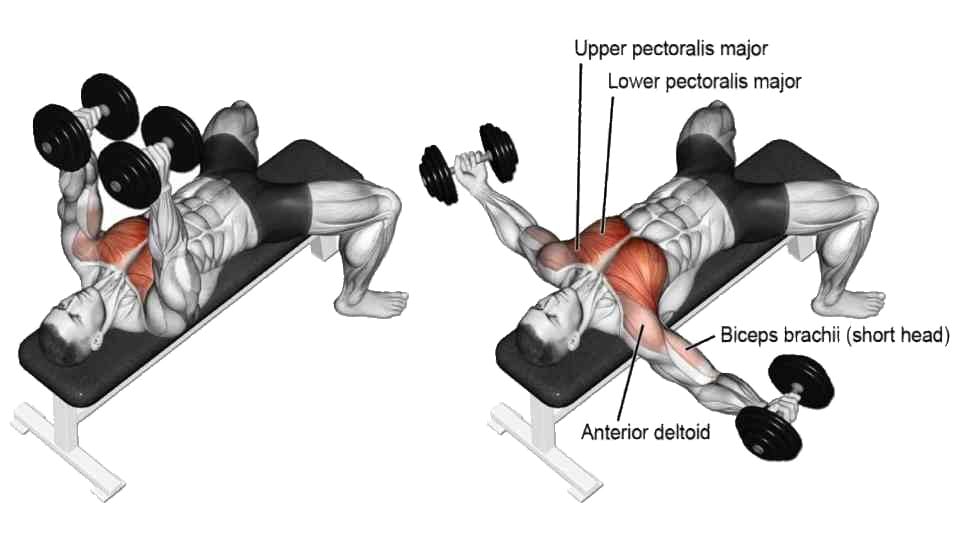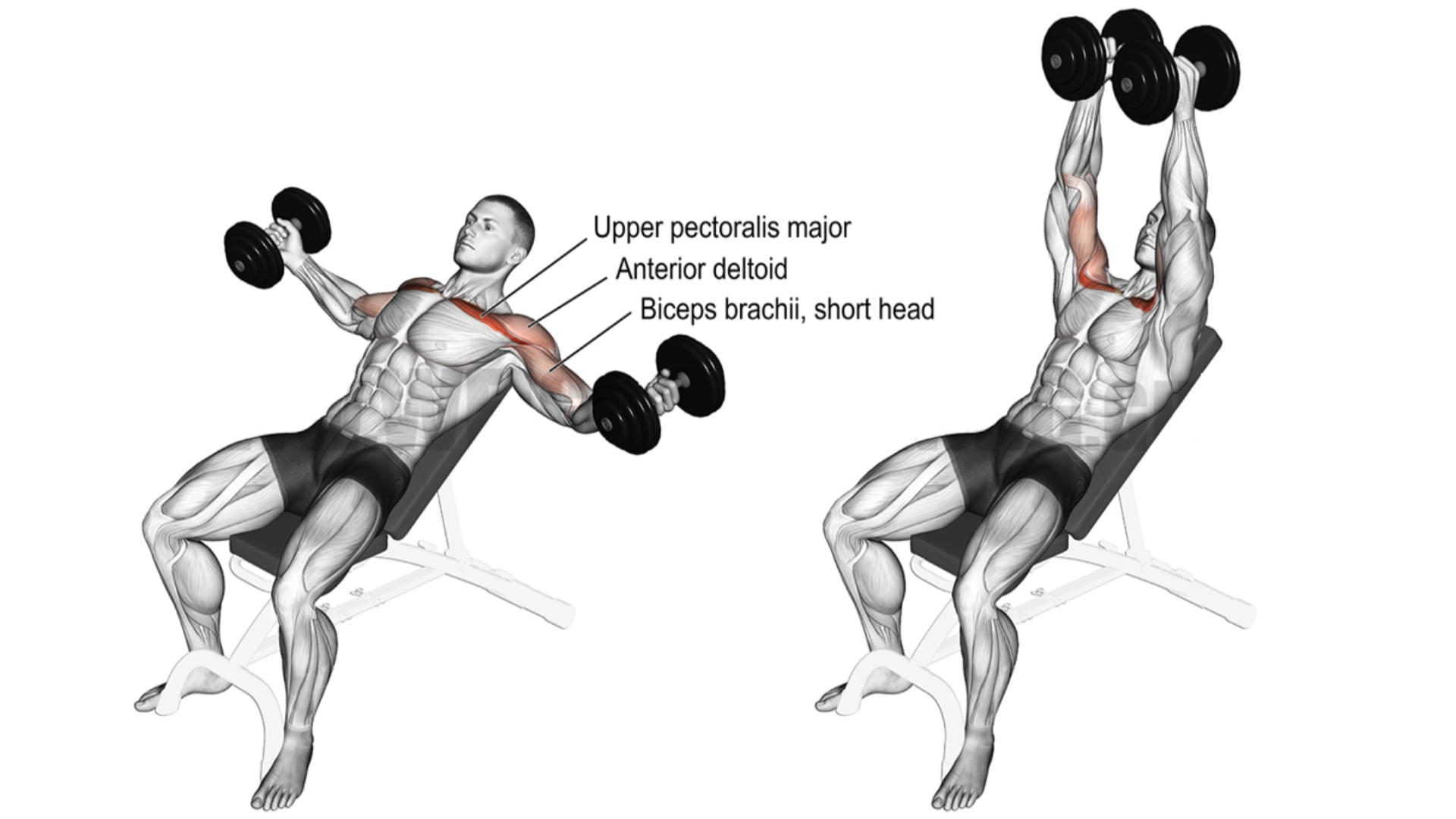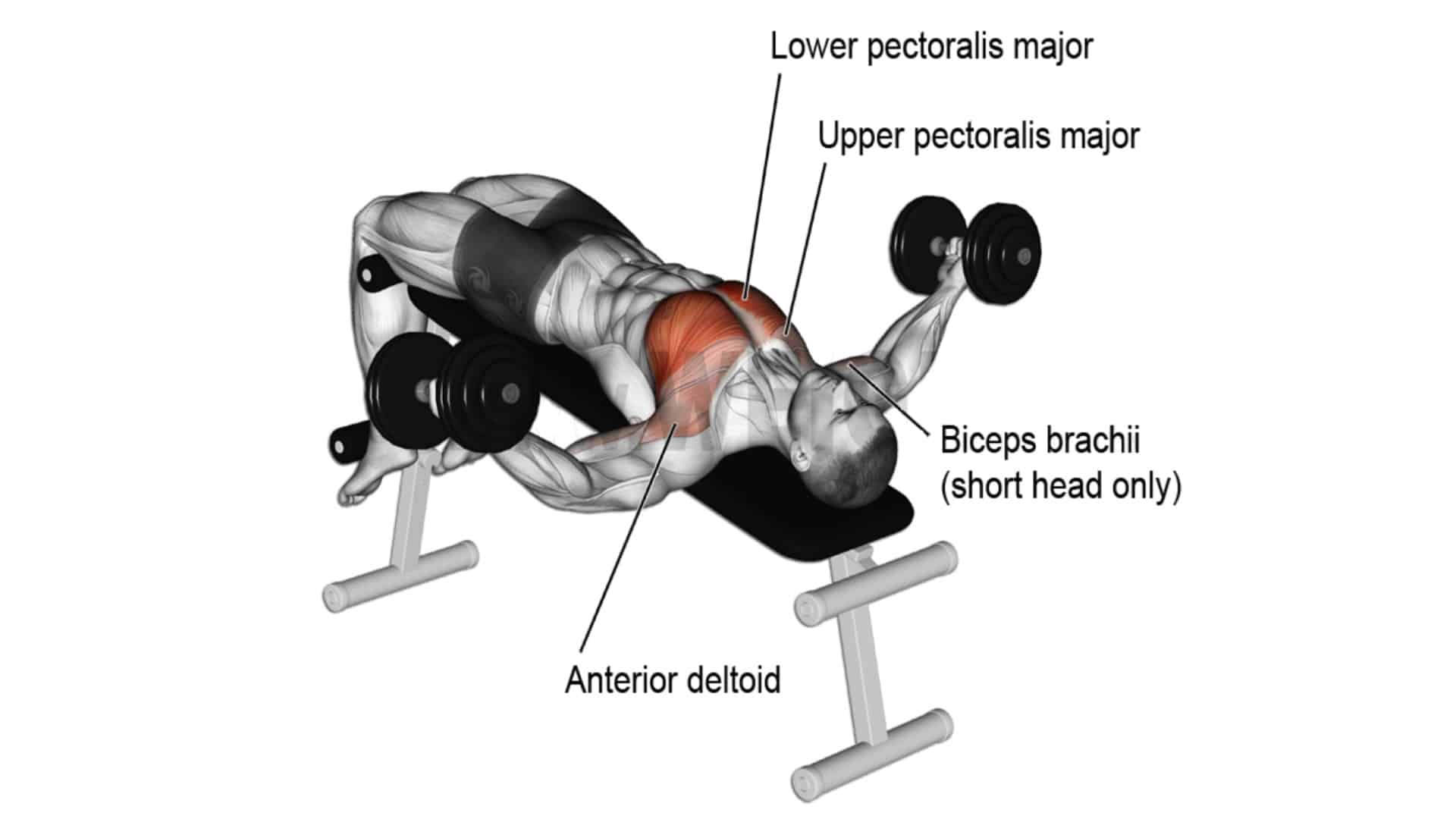If you want to build a bigger, better-shaped chest, dumbbell chest fly are a must-have addition to your chest workout routine. Increasing your chest’s strength doesn’t just make you look better, it also helps you feel stronger.
The dumbbell fly, a bodybuilding favorite, is a chest isolation exercise and is usually performed after big compound lifts, such as the Barbell press and incline bench press.
In this comprehensive guide, we will provide you with everything you need to know.
- What is Dumbbell Chest Fly
- Muscles Worked During Dumbbell Chest Fly
- Its Benefits
- How To Do It Properly
- Proper form and technique
- Variations and Progressions

- What is Dumbbell Chest Fly
- Muscles Worked During Dumbbell Chest Fly
- Benefits of Chest Dumbbell Fly
- How To Do Dumbbell Chest fly
- Dumbbell Chest Fly Form and Technique
- Best Variations Of Chest Dumbbell Fly
- 1. Incline Dumbbell Fly
- 2. Decline Dumbbell Fly
- 3. Standing Upward Dumbbell Chest Fly
- Best Alternative of Dumbbell Fly
- 1. Seated Machine Fly
- 2. Dumbbell Squeeze Press
- 3. Incline Cable Fly
- 4. Low Pulley Cable Crossover
- 5. Push-Ups
- Takeaway
- FAQ
- Are dumbbell chest flys good?
- Are standing dumbbell flys good for chest?
- What muscles do dumbbell chest flys work?
- Do chest flys build mass?
- Should I do flat or incline flyes?
- Know More About Chest Training
- Resources
- 10 Best Upper Chest Exercises To Build Mass and Strength
What is Dumbbell Chest Fly
Dumbbell chest flyes are an isolation exercise and are usually performed after compound exercises, such as the decline bench press and barbell press. The dumbbell fly is considered to be the perfect finishing move and a great way to focus on your chest after a lot of pressing exercises.
It is highly versatile and thus very effective in a weight-training regimen. Although you perform the basic exercise while lying horizontally on a bench, using an incline or decline bench allows you to adjust the exercise to add variety to your workout.
The target muscle between the traditional and decline dumbbell fly changes as the angle of the bench changes. And using a decline bench provides a challenging variation to the exercise. I
Flies can be performed using any weight that can be held in the hand. The simplest equipment to use is a dumbbell, though the exercise can also be performed using a cable machine. Dumbbell fly can be performed supine, sitting or standing upright.
Muscles Worked During Dumbbell Chest Fly
A dumbbell fly works the primary work your chest and as well as the fronts of the shoulders. These muscles allow you to move your arm across your chest, such as in a pressing or hugging motion.
Dumbbell fly also engages the rhomboids at the upper back and the biceps as stabilizing muscles.
The move involves the rotator cuff and the back of the shoulders, as well as the serratus anterior, a muscle along the ribs that helps keep your shoulders in proper alignment.

Benefits of Chest Dumbbell Fly
- The dumbbell chest fly can help open up your chest muscles. Chest openers may help reduce upper back pain, increase range of motion, and reduce tightness in the upper body.
- Having a stronger chest will not only enhance your physique, but will also help you out with daily activities and improve your sporting performance.
- While the main focus of a dumbbell fly is on your chest, it will also target muscles in your shoulders, back, and arms which are used to help stabilize the weight during the exercise.
- The dumbbell fly doesn’t require much equipment to perform. You can do dumbbell flyes while lying on the floor if you don’t have a bench.
How To Do Dumbbell Chest fly
The dumbbell fly utilizes a chest fly movement pattern to isolate the muscles of the chest, helping the muscles to grow better and become stronger.
It is a great exercise for targeting and strengthening your chest muscles. To ensure you perform it correctly and reap the maximum benefits, follow these step-by-step instructions:

- Lie flat on a bench with your feet firmly planted on the ground.
- Hold a dumbbell in each hand with a neutral grip (palms facing each other).
- Hold your arms straight up in front of you, keeping your elbows bent slightly.
- Slowly lower the dumbbells out to the sides in a wide arc, while maintaining a slight bend in your elbows.
- Keep your wrists firm and keep control throughout the movement.
- Keep lowering the dumbbells until your arms are parallel to the ground or slightly below the ground, and you feel a stretch in your chest muscles.
- Pause for a moment at the bottom of the movement, focusing on the contraction in your chest.
- Use your chest muscles to lift the dumbbells back up to where you started.
- Repeat For the desired number of reps.
Dumbbell Chest Fly Form and Technique
- Start with a light set of dumbbells, if you’re a beginner, and slowly increase the amount of weight each week as you build strength.
- Don’t let the dumbbells touch as they meet at the top, holding for a second in the contracted position.
- Make sure you keep your elbows bent. You should never fully straighten your arms, or lock them out, as this forces the weight you’re lifting onto the elbows and shoulder joints, which increases your chance of injury.
- Don’t let your elbows drop too far when you’re in the start position, they should remain in line with your torso when you’re lying on the bench.
- Avoid using momentum or swinging your arms when lifting the dumbbells. Slow and deliberate motions engage the chest muscles more effectively.
- Maintain control, with a 4-second descent, slight pause and contract with a reverse motion, hold and repeat.
- Pick a weight that you can control, that’s not too light or too heavy — find what’s right for you.
- Maintain tension in your abs and don’t allow your lower back to excessively arch.
Best Variations Of Chest Dumbbell Fly
The dumbbell fly can be done in different ways to suit your fitness level.
If you are a dumbbell chest fly, you may want to apply a few modifications to make the easier. One way to achieve this is by doing dumbbell flies on a flat bench, or by using a lighter weight.
If you are looking for a more advanced variation to stimulate different muscle fibers in the chest, then try incline dumbbell fly, decline dumbbell fly and standing upward chest fly.
You can make it more challenging by adjusting the bench angle and using heavier weight. But please focus on form while you’re doing it.
1. Incline Dumbbell Fly
The incline dumbbell fly is a variation of the dumbbell fly exercise that specifically targets the upper chest muscles (pectoralis major) while also engaging the shoulders and triceps.
Performing dumbbell fly exercise on an inclined bench changes the angle of movement and places greater emphasis on the upper chest area.

How To Do Incline Dumbbell Fly
- Set an incline bench at a 30-to 45-degree angle.
- Lie on the bench with your feet flat on the floor.
- Hold a dumbbell in each hand with a neutral grip (palms facing each other)
- Lift your arms straight up from your shoulders and the dumbbells directly over your upper chest.
- Slowly lower your arms out to your sides until your wrists come to about shoulder level or slightly above
- Bring your arms back toward the midline of your body, focusing on using your pec muscles to draw them back together.
Tips for Proper Form
- Focus on a slow and controlled movement.
- Keep your shoulder blades retracted and depressed throughout the movement
- Set the bench at about 30-45 degrees inclined. Do not go more upright as the stress shifts more to the shoulders rather than the chest area.
2. Decline Dumbbell Fly
The decline dumbbell fly is another variation of the dumbbell fly exercise that targets the lower portion of the chest muscles (pectoralis major).
Performing the chest dumbbell fly on a decline bench engages the lower chest muscles more deeply, stimulating muscle growth and strength in that area.

How To Do Decline Dumbbell Fly
- Set a decline bench at an angle of about 30-45 degrees.
- Lie back on the bench with your head positioned at the lower end and secure your feet in the foot pads or anchor them under a stable surface.
- Hold a dumbbell in each hand with a neutral grip (palms facing each other). Extend the dumbbells above your chest.
- Lower the dumbbells to the sides in a wide arc. Try to feel the stretch in your lower chest muscles.
- Move your arms back to the middle of your body and use your pec muscles.
Tips for Proper Form
- Keep the movement slow and controlled.
- Use a slight decline, such as 30 degrees. Extremes are never the best option.
- If you’re using very heavyweights, have a spotter to handle dumbbells for you once your body is in position.
3. Standing Upward Dumbbell Chest Fly
Standing dumbbell chest fly is a good exercise to target your upper chest. With only a pair of dumbbells, you can make your chest area broader and more developed.
Since the exercise involves lifting the dumbbells up while standing, it also works the anterior deltoids and core muscles for stability.

How To Do Standing Upward Chest Fly
- Stand upright with your feet shoulder-width apart and hold a dumbbell in each hand with a neutral grip.
- The dumbbells should be at your sides.
- Lift both dumbbells in an arc motion in front of you.
- Continue raising the dumbbells until your arms are parallel to the ground or slightly above.
- Take a pause at the top of the movement and focus on squeezing your upper chest muscles.
- Slowly lower the dumbbells back down to the starting position, maintaining control throughout the motion.
- Repeat for the desired number of repetitions.
Tips for Proper Form
- Keep your core engaged and maintain an upright posture
- Exhale during the concentric (muscle-shortening) part of the motion.
- Your arms and shoulders will work, but most of the work should be done with the pecs.
Best Alternative of Dumbbell Fly
Before we deep dive into the best dumbbell fly alternatives. We must remember, a good dumbbell chest fly alternative will be able to satisfy the following criteria:
- Activate the chest muscle groups that are trained with the dumbbell chest fly.
- Isolate the muscle groups during execution
- Train the chest muscle through a longer range of motion
1. Seated Machine Fly
The machine chest fly is a machine exercise that primarily targets the chest and is the best alternate of a dumbbell fly. You really need the machine to fly equipment.
There are many machines fly variations that you can try out, which require different types of machine fly equipment, or may even require no equipment at all.
2. Dumbbell Squeeze Press
The dumbbell squeeze press is a great alternative to the dumbbell fly to develop the pectoral muscles.
During the squeeze press, the dumbbells are kept in contact with each other at all times, and you’re actively squeezing them inward (against each other) as hard as possible.
3. Incline Cable Fly
Incline Cable fly is one of the most suitable exercises for isolating the upper chest muscles. If a cable setup is available, you should try it as an alternative to dumbbell fly.
Performing this exercise with cables instead of dumbbells allows for constant tension, which helps build upper chest fibers, it is the best alternate of Incline dumbbell fly.
4. Low Pulley Cable Crossover
Low pulleys cable crossover exercise helps to build huge pectorals. The cable provides constant tension, helping build upper pecs. Standing cable crossovers exercise helps to develop and define upper and inner pectoral muscles.
Cable provides constant resistance and helps develop central chest muscles and providing the much-needed stress and inner pecs, for which bodybuilders crave.
5. Push-Ups
Push-ups are a classic and versatile exercise that engage multiple muscle groups, including the chest, shoulders, and triceps.
They can be modified to target different areas of the chest, such as
- Incline push-ups to emphasize the upper chest,
- Decline push-ups to target the lower chest.
Takeaway
The dumbbell chest fly may be a good exercise to strengthen your chest, shoulder, and arm muscles. Dumbbell flyes are often overlooked, especially when compared to other chest exercises. If you want to develop a well-shaped chest and added thickness, they are just as important as the flat bench press.
If you are a beginner, it is best to start with a light set of dumbbells. As you gain strength, you can slowly increase the amount of weight.
FAQ
Are dumbbell chest flys good?
Yes, dumbbell chest fly is the good exercise, that can help to open up your chest muscles. If you want to develop a well-shaped chest and added thickness, then the incline and declines fly are equally important to the bench press.
Chest openers may help reduce upper back pain, increase range of motion, and reduce tightness in the upper body.
Are standing dumbbell flys good for chest?
Standing dumbbells fly is a good exercise to target your Mid and upper chest. It is also a good alternative to dumbbell fly, which you can do at home with only a pair of dumbbells. Standing dumbbell fly can make your chest area broader and more developed.
What muscles do dumbbell chest flys work?
When you are doing a dumbbell fly, you work both of your chest muscles: the larger pectoralis major and the smaller pectoralis minor. As you switch between incline and decline positions, the muscles worked during the dumbbell fly will also change. The incline dumbbell fly focuses more on the upper pecs, and the decline dumbbell chest fly works the lower pecs.
Do chest flys build mass?
Chest fly is an isolation exercise. To build mass and gain overall muscle growth from compounds, which work multiple muscle fibers, we need to add isolation exercises as well.
Should I do flat or incline flyes?
Both of these exercises are excellent for building chest muscles, and each allows you to work different muscles.
Know More About Chest Training
- Cable fly: Muscle Worked, Alternate, Variations
- 10 Best Lower Chest Exercises and Workout
- Incline Chest Fly: Benefits, Muscles Worked, Form
- Decline Cable Fly: Muscle Worked, Benefits, Alternate
- 10 Best Chest Workout With Dumbbells at Home or Gym
Resources
- Rohmann R. (2014). Beginner strength training workout. https://www.acefitness.org/education-and-resources/lifestyle/blog/3714/beginner-strength-training-workout
- Krzysztofik M, Wilk M, Wojdała G, Gołaś A. Maximizing Muscle Hypertrophy: A Systematic Review of Advanced Resistance Training Techniques and Methods. Int J Environ Res Public Health. 2019 Dec 4;16(24):4897. doi: 10.3390/ijerph16244897. PMID: 31817252; PMCID: PMC6950543.
- Schoenfeld BJ, Contreras B, Krieger J, Grgic J, Delcastillo K, Belliard R, Alto A. Resistance Training Volume Enhances Muscle Hypertrophy but Not Strength in Trained Men. Med Sci Sports Exerc. 2019 Jan;51(1):94-103. doi: 10.1249/MSS.0000000000001764. PMID: 30153194; PMCID: PMC6303131.
10 Best Upper Chest Exercises To Build Mass and Strength

Manish brings over 10 years of hands-on experience in weight lifting and fat loss to fitness coaching. He specializes in gym-based training and has a lot of knowledge about exercise, lifting technique, biomechanics, and more.
Through “Fit Life Regime,” he generously shares the insights he’s gained over a decade in the field. His goal is to equip others with the knowledge to start their own fitness journey.
